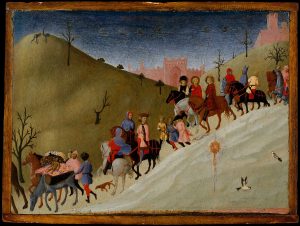
Pilgrimage was long a reigning metaphor in Christian Europe for the state of the human soul. Where does home really reside?
It was a true pleasure reading my peers’ beautiful and eloquent reflections on home. Some dwelt on aspects of place: the sights, sounds, and scents, for example, that may often go unnoticed but end up making an important part of who we are. I suspect this is an especially familiar thread in Canadian stories of home (although not exclusive to them); we need only think of BC’s self-promotion as “Super, Natural British Columbia” to remember the extent to which a certain experience of land characterizes the image of a Canadian identity.
Other stories focused on home as a cognitive and/or social structure, a web of memories, activities, and relationships. A space of interaction between people.
Our accounts of home often hinged on narratives of travel. It is not surprising, maybe, that departures from and movements of the people we know and love, returns to the places we recognize, shape our experience of home. This is a factor of some individuality, as no two person’s histories of motion and travel are exactly the same. (I can say with the splendid Scottish writer Nan Shepherd that I’ve slept in the same bedroom for practically my entire life!) That being said, the same (or similar) conditions of mobility characteristic of contemporary society have surely had no small impact on how we live and think of home.
I think of John Clare (who lived some two hundred years ago) and his haunting words on relocation and desolation in “The Flitting”:
I’ve left my own old home of homes,
Green fields and every pleasant place;
The summer like a stranger comes,
I pause and hardly know her face.
I miss the hazel’s happy green,
The blue bell’s quiet hanging blooms,
Where envy’s sneer was never seen,
Where staring malice never comes. (1-8)
And this was for a move between the villages Helpston and Northborough in Cambridgeshire, which were all of (as I reckon) four or five kilometers apart. (Clare faced more traumatic dislocations in his life, and died in an asylum.) How has home changed its meaning? How does that meaning still change between cultures, between individuals?
One common (you could say “formal”) feature struck me especially: lyrical rhythms of repetition with recurring phrases like “Home is . . . ” or “I am home.” I think that this testifies on one level to the unclosedness of home as a concept, its in-built tendency to change over time and acquire new meanings. But that changeability involves a recurrence, something like the refrain of songs like “Galway Bay.” (That is a song my grandmother loves. My family is mainly Irish and Scottish in origin; both the Irish and the Scots have large diasporic communities and strong traditions of nostalgia.) Or Robert Burns’s “My Heart’s in the Highlands” and “Auld Lang Syne.” There is a sense of finding a home through these rehearsals and repetitions of loss and yearning—as John Keats locates a feeling of belonging in the embodied rhythms of a sleeping lover’s breath.
I think also that there’s a parallel with the atmospheric rhythms that punctuate our experience—like the seasons. To give one example: there has been ice in the Fraser near where I live these past few cold days. This is the first time we’ve seen so much freezing in years. Walking out onto the river a little ways, I remembered doing the same with my brother several years ago, when the ice was even thicker—an unforgettable experience. More than that, looking over the frozen expanse towards far wooded shores brought to consciousness an early childhood image of the Canadian North: tundra, frozen rivers, mountains, pine forests, a land of wolves and ravens. I don’t even know where this picture really came from. A movie? But this fantasy world, which doesn’t even truly exist, has been part of what “home” means to me. This fact came to me in a visionary instant.
Works Cited
“Ascent to greatness: the charmed afterlife of Nan Shepherd.” The Scotsman, 9 January 2017, https://www.scotsman.com/arts-and-culture/books/ascent-greatness-charmed-afterlife-nan-shepherd-1458734. Accessed 15 February 2021.
Clare, John. “The Flitting.” Poemhunter, 13 April 2010, https://www.poemhunter.com/poem/the-flitting/.
“John McDermott – Galway Bay.” Youtube, uploaded by LadyGreyCarolyn, 31 January 2014, https://youtu.be/EHkM51ywUZo.
Keats, John. “Bright star, would I were stedfast as thou art.” Poetry Foundation, https://www.poetryfoundation.org/poems/44468/bright-star-would-i-were-stedfast-as-thou-art. Accessed 15 February 2021.
Owen, Siobhàn. “Siobhàn Owen ~ Auld Lang Syne.” Youtube, uploaded by Siobhàn Owen, 27 December 2015, https://youtu.be/TRpdzmMH4f4.
Polwart, Karine. “Karine Polwart – My Heart’s in the Highlands (Robert Burns).” Youtube, uploaded by Петар Жутић, 23 February 2012, https://youtu.be/9HuHTkDw9Sw.
“Super, Natural BC – British Columbia Travel Information.” HelloBC, https://www.hellobc.com/. Accessed 15 February 2021.
Image Credit
Sassetta (Stefano di Giovanni). The Journey of the Magi. Ca. 1433-35. The Met Fifth Avenue, New York. The Met, https://www.metmuseum.org/art/collection/search/437611. Accessed 15 February 2021.